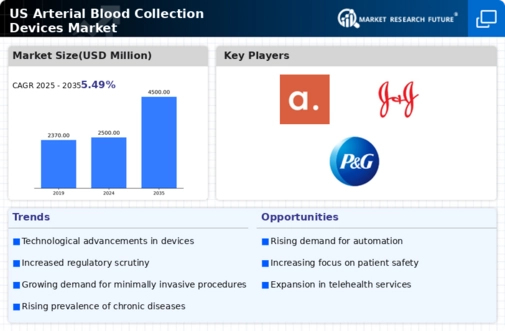Growing Awareness of Blood Donation
The increasing awareness of the importance of blood donation significantly influences the arterial blood-collection-devices market. Campaigns promoting blood donation and the establishment of blood donation centers across the US have led to a heightened demand for efficient blood collection devices. Organizations such as the American Red Cross actively engage in initiatives to encourage voluntary blood donations, which in turn drives the need for advanced arterial blood-collection devices. The market is likely to benefit from this trend, as improved devices can enhance the overall donation experience, making it more appealing for potential donors. This growing awareness and participation in blood donation initiatives are expected to contribute positively to the arterial blood-collection-devices market.
Rising Demand for Diagnostic Testing
The arterial blood-collection-devices market experiences a notable surge in demand due to the increasing prevalence of chronic diseases such as diabetes and cardiovascular disorders. As healthcare providers emphasize early diagnosis and continuous monitoring, the need for efficient blood collection methods becomes paramount. In the US, the market for diagnostic testing is projected to reach approximately $70 billion by 2026, indicating a robust growth trajectory. This trend is likely to drive innovation in arterial blood-collection devices, enhancing their efficiency and reliability. Furthermore, the growing awareness among patients regarding the importance of regular health check-ups contributes to the rising demand for these devices, thereby propelling the arterial blood-collection-devices market forward.
Technological Innovations in Device Design
Technological advancements play a crucial role in shaping the arterial blood-collection-devices market. Innovations such as automated blood collection systems and smart devices equipped with sensors are transforming traditional practices. These advancements not only improve the accuracy of blood sampling but also enhance patient comfort and reduce the risk of complications. The integration of digital technologies, such as mobile applications for tracking blood collection, is also gaining traction. As a result, the market is expected to witness a compound annual growth rate (CAGR) of around 6% over the next five years. This growth is indicative of the increasing investment in research and development aimed at creating more efficient and user-friendly arterial blood-collection devices.
Regulatory Support for Innovative Solutions
Regulatory bodies in the US are increasingly supportive of innovations in the arterial blood-collection-devices market. Initiatives aimed at expediting the approval process for new medical devices encourage manufacturers to invest in research and development. The Food and Drug Administration (FDA) has implemented programs that facilitate faster access to market for breakthrough technologies, which is likely to stimulate competition and innovation. As a result, the market is expected to see a rise in the introduction of advanced arterial blood-collection devices that meet stringent safety and efficacy standards. This regulatory environment not only fosters innovation but also enhances consumer confidence in the products available, thereby positively influencing the growth of the arterial blood-collection-devices market.
Increasing Focus on Home Healthcare Solutions
The shift towards home healthcare solutions significantly impacts the arterial blood-collection-devices market. With an aging population and a growing preference for at-home medical services, there is a rising need for devices that facilitate blood collection outside traditional clinical settings. This trend is further supported by advancements in telemedicine, which enable remote monitoring and consultations. The market for home healthcare is projected to reach $300 billion by 2025 in the US, suggesting a substantial opportunity for arterial blood-collection devices designed for home use. Consequently, manufacturers are likely to focus on developing portable and easy-to-use devices that cater to this emerging segment, thereby driving growth in the arterial blood-collection-devices market.














Leave a Comment